Worth Sharing:
http://www.baen.com/author_catalog.asp?author=RAHeinlein Click around the Baen site for some howlers of noisey, undirected composition, overblown and gaudy type treatments, classic muscle men and chainmail bikinis and the occasional surprising gem of kitsch.
http://spacesick.blogspot.com/2009/01/i-can-read-movies-series.html There are a few of these going around, especially at the very NSFW 'Something Awful' photoshopphriday section, but spacesick (untrained in Graphic design, a testament to his natural talent)is among the best. His covers have even been featured in Creative Review (Mar 2009). What is so excellent about them is how he (instinctively?) boils something essential about the movies into a simple two tone illustration.
Tuesday, 27 April 2010
Friday, 23 April 2010
Book List As It Stands
The votes are in and lots of factors have been considered, over quite a long period of time. Although subject to change, the layout is:
Core Choices
William Gibson Burning Chrome
Robert A Heinlein Time Enough for Love
Ursula Le Guin Wizard of Earthsea
Margaret L'Engle A Wrinkle In Time
Backup Choice
Arthur C Clarke Rendezvous with Rama
Richard Matheson Incredible Shrinking Man
Joanna Russ The Female Man
Anne McCaffrey Dragonflight
Thanks to everyone so far, your input has been enlightening and invaluable.
Core Choices
William Gibson Burning Chrome
Robert A Heinlein Time Enough for Love
Ursula Le Guin Wizard of Earthsea
Margaret L'Engle A Wrinkle In Time
Backup Choice
Arthur C Clarke Rendezvous with Rama
Richard Matheson Incredible Shrinking Man
Joanna Russ The Female Man
Anne McCaffrey Dragonflight
Thanks to everyone so far, your input has been enlightening and invaluable.
Blimey
Gollanzc isn't doing to bad with some of their titles- have a look at the paper based images here http://bookcoverarchive.com/publisher/gollancz_orion_pub_group
Well I'm going to do better.
Well I'm going to do better.
More books I like
I remembered I was actually quite fond of Emma Wallace's fairly minimalist work on Steph Swainston's "New Weird" fantasy books But all her work is pretty Inspiring. Check it out: http://bookcoverarchive.com/emma_wallace
Image via Amazon:


Also how much can be picked up from ages past: http://www.lib.rochester.edu/index.cfm?page=3348 esp Lark of the planets.
Image via Amazon:


Also how much can be picked up from ages past: http://www.lib.rochester.edu/index.cfm?page=3348 esp Lark of the planets.
Wednesday, 21 April 2010
Other Cover Worth a Mention
The Hitch Hiker's Guide To The Galaxy is one of my All time favourite covers. I grew up with this edition and will defend it to the death (Image via Wikimedia).

It was re-released as the cover design in 2005, to coincide with the film, sduch was the nation's affection for it's garish video colours- with the idiotic omission of "Don't Panic" in big, friendly letters from the back.
Well lets look back at the task I've got. This is basically a relaunch. What have we had in the past that were striking and effective relaunches of one sort or another.
Penguin Great Ideas: Four Series of these slim, white books with typographic letter pressed covers. They are gorgeous. It is to my greatest chargrin that I only own a couple of them, cruelly faded by sunlight. They are simply lovely to hold. Jim Stoddart and his team have won enough awards for this range and need no further praise from me.
2008 Bond Relaunch, again by Penguin. Now what these do is entirely embrace audience expectations of the books and turns is back up them, volume set to 11. The texture and form of them is entirely pulp-y and sex-ploitation-y, but this become fitting an apt when seen as a set, fun and energetic. This is one of the outcomes of post-modernism, the embracing by not-so-much re-appropriation (how is it being re-appropriated, instead of just being used for the same-as-original purpose?) but reclamation and re-use. Whereas modernism would try to rationalise the end result of this process, in a post modern era we can amplify out emotional response. Sex and typography, as Robert Brownjohn might have it. (Images Via http://bullyscomics.blogspot.com/ and Kitsunenoir.com)



Bully's comics also provides an excellent view of Bond covers through the ages.
In 2006 penguin re-released some of their classics with covers commissioned from artists from the world of graphic novels, comics and cartooning. While seems seems to be faddish- following the success and media attention around films based on comics and graphic novels such as Sin City, the results were still quite interesting. Here are some via Amazon




Yes we are back to illustration- but where it's not expected, where it is interesting, sometimes critical, and original. None of them really change the 'look' of the book or shatter preconceptions- to the credit of the artists aptness is never in question. Which brings us to the problem that is a sticking point for me. People want what they expect. They also need to be surprised and shown things in a new way. Informal interviews have told me that both fans and non-fans of fantasy books have a stereotype in their heads of the sort of covers I blogged links to earlier on, spaceship and metal bikinis and musclemen, painted to varying qualities. But fans actually expected Fantasy/SF books to look much as they do now, with a heavy emphasis on how well they look as a set, and how identifiable they are. What the bond books achieved was new-old look, and they managed it by seeking out an approach that defied and yet was sympathetic to the expectations of the audience. Sympathy requires empathy and, usually, a measure of affection. Letter pressed 50s rocket ship in deep purple under an entirely typed layout? I need to get sketching.

It was re-released as the cover design in 2005, to coincide with the film, sduch was the nation's affection for it's garish video colours- with the idiotic omission of "Don't Panic" in big, friendly letters from the back.
Well lets look back at the task I've got. This is basically a relaunch. What have we had in the past that were striking and effective relaunches of one sort or another.
Penguin Great Ideas: Four Series of these slim, white books with typographic letter pressed covers. They are gorgeous. It is to my greatest chargrin that I only own a couple of them, cruelly faded by sunlight. They are simply lovely to hold. Jim Stoddart and his team have won enough awards for this range and need no further praise from me.
2008 Bond Relaunch, again by Penguin. Now what these do is entirely embrace audience expectations of the books and turns is back up them, volume set to 11. The texture and form of them is entirely pulp-y and sex-ploitation-y, but this become fitting an apt when seen as a set, fun and energetic. This is one of the outcomes of post-modernism, the embracing by not-so-much re-appropriation (how is it being re-appropriated, instead of just being used for the same-as-original purpose?) but reclamation and re-use. Whereas modernism would try to rationalise the end result of this process, in a post modern era we can amplify out emotional response. Sex and typography, as Robert Brownjohn might have it. (Images Via http://bullyscomics.blogspot.com/ and Kitsunenoir.com)



Bully's comics also provides an excellent view of Bond covers through the ages.
In 2006 penguin re-released some of their classics with covers commissioned from artists from the world of graphic novels, comics and cartooning. While seems seems to be faddish- following the success and media attention around films based on comics and graphic novels such as Sin City, the results were still quite interesting. Here are some via Amazon




Yes we are back to illustration- but where it's not expected, where it is interesting, sometimes critical, and original. None of them really change the 'look' of the book or shatter preconceptions- to the credit of the artists aptness is never in question. Which brings us to the problem that is a sticking point for me. People want what they expect. They also need to be surprised and shown things in a new way. Informal interviews have told me that both fans and non-fans of fantasy books have a stereotype in their heads of the sort of covers I blogged links to earlier on, spaceship and metal bikinis and musclemen, painted to varying qualities. But fans actually expected Fantasy/SF books to look much as they do now, with a heavy emphasis on how well they look as a set, and how identifiable they are. What the bond books achieved was new-old look, and they managed it by seeking out an approach that defied and yet was sympathetic to the expectations of the audience. Sympathy requires empathy and, usually, a measure of affection. Letter pressed 50s rocket ship in deep purple under an entirely typed layout? I need to get sketching.
These were blogged elsewhere- More on Harry Potter.
I wasn't very taken with them, but when they turned up on Grafik magazine I thought about them again. Now they are fairly obviously anachronistic- 7's pseudo cut vinyl print effects rendered in contemporary colours and a bit of (maybe naff?) glamour at the top.

But, you see, that's what Harry Potter has to be now. It's no longer an event. It's a brand and brands exist in memory (especially emotional memory). The next Harry Potter book can't look like the last in the line because there will not be another next-in-the-line. Even the movies are nearly done with. So Harry Potter can't be a thing of the moment- it has to be dislocated from the moment. That way it can stay on the shelves long after it has stopped being fashionable.
So what have I been doing today? Mostly reading, Derek Birdsall, John Hohculli and 'Really Great Packaging Explained'- which is full of very sound (sounding) real world design advice. I have been thinking about the Grid, especially after Germano Facetti and Dave Pelham's work on Penguin. I've always used something like Birdsall's Modular grid, but my base units have usually been derived from one or two key x heights (which might account for my being stingy with lead). What if we tried artwork or photography, but broke Birdsall's rule of respecting it and cropped it to the point of abstractions, found some detail that bridges two worlds. Chest is full of the interstitial shapes and objects...
Reading is a bad habit, and most of the books are about internal typography, which is a separate issue- insights on format and jackets are what I need. I also need to stop reading. It's keeping me from taking the plunge into my sketch pad.

But, you see, that's what Harry Potter has to be now. It's no longer an event. It's a brand and brands exist in memory (especially emotional memory). The next Harry Potter book can't look like the last in the line because there will not be another next-in-the-line. Even the movies are nearly done with. So Harry Potter can't be a thing of the moment- it has to be dislocated from the moment. That way it can stay on the shelves long after it has stopped being fashionable.
So what have I been doing today? Mostly reading, Derek Birdsall, John Hohculli and 'Really Great Packaging Explained'- which is full of very sound (sounding) real world design advice. I have been thinking about the Grid, especially after Germano Facetti and Dave Pelham's work on Penguin. I've always used something like Birdsall's Modular grid, but my base units have usually been derived from one or two key x heights (which might account for my being stingy with lead). What if we tried artwork or photography, but broke Birdsall's rule of respecting it and cropped it to the point of abstractions, found some detail that bridges two worlds. Chest is full of the interstitial shapes and objects...
Reading is a bad habit, and most of the books are about internal typography, which is a separate issue- insights on format and jackets are what I need. I also need to stop reading. It's keeping me from taking the plunge into my sketch pad.
Tuesday, 20 April 2010
Obstructions are opportunities.
While talking to the ever inspirational (not to mention charming, intelligent and head-turning) Phatamgoricist I hit on the notion of limitations, probably with this film running in the back of my head: The Five Obstructions
I was talking about how just illustrating is a really obvious, and essentially uncreative, response to the challenge of represent a book visually.
So what happens to you idea gen, to your results, to your approach if you put on limitations
"Visually represent this book's content." results in illustrations
"Visually represent this book's content using only type."
"Visually represent this book's content using only colour."
"Visually represent this book's content using only geometric shapes."
"Visually represent this book's content using only one geometric shape and one colour."
"Visually represent this book's content using only one line of type and two colours."
"Visually represent this book's content using only one letterform, any face."
So the question becomes which line of type, which colour? How do I surprise and communicate to the viewer? What shape or typeface combinations have the right tone?
And it produces very thought provoking results, see this entry from (NSFW, as design collector often is) designcollector.net, particularly these approaches to TV shows:

So how far can you push it?
"Visually represent this book's content using only one print or weave of fabric."
"Visually represent this book's content using only a texture."
"Visually represent this book's content using only rubbing a texture."
"Typeset only one sentence of this book to make an effective cover."
"Create your book cover with only one application of Indian Ink."
"Derive you book cover design from one letterform from Helvetica Neue."
"Visually represent this book's content using only two circles."

Design by Germano Facetti 1975. Image thanks to coverbrowser.com
So what limitations should I apply?
I was talking about how just illustrating is a really obvious, and essentially uncreative, response to the challenge of represent a book visually.
So what happens to you idea gen, to your results, to your approach if you put on limitations
"Visually represent this book's content." results in illustrations
"Visually represent this book's content using only type."
"Visually represent this book's content using only colour."
"Visually represent this book's content using only geometric shapes."
"Visually represent this book's content using only one geometric shape and one colour."
"Visually represent this book's content using only one line of type and two colours."
"Visually represent this book's content using only one letterform, any face."
So the question becomes which line of type, which colour? How do I surprise and communicate to the viewer? What shape or typeface combinations have the right tone?
And it produces very thought provoking results, see this entry from (NSFW, as design collector often is) designcollector.net, particularly these approaches to TV shows:

So how far can you push it?
"Visually represent this book's content using only one print or weave of fabric."
"Visually represent this book's content using only a texture."
"Visually represent this book's content using only rubbing a texture."
"Typeset only one sentence of this book to make an effective cover."
"Create your book cover with only one application of Indian Ink."
"Derive you book cover design from one letterform from Helvetica Neue."
"Visually represent this book's content using only two circles."

Design by Germano Facetti 1975. Image thanks to coverbrowser.com
So what limitations should I apply?
Just an idea I wanted to get out of my head.
Hadn't realised how inspired by Nina Tara's stuff it was until I post the last entry:
Anyway, just so it is on paper and not bothering my mind (all images copyright Leigh Woosey 2010 unless otherwise stated). Found some beautiful Encaustic textures on creative commons and just had to use 'em:




Click to embiggen the images.
Anyway, just so it is on paper and not bothering my mind (all images copyright Leigh Woosey 2010 unless otherwise stated). Found some beautiful Encaustic textures on creative commons and just had to use 'em:




Click to embiggen the images.
Bumps in the Road.
Computer (well, email) being hacked into, job interviews, sleepless nights. I hate when real life gets in the way of design. Anyway, to make up for it here's a quick post of sf/fantasy book covers I do like:
Dianna Wynn Jones' Howl books, images from Amazon and the excellent Nina Tara, who is responsible for these designs:
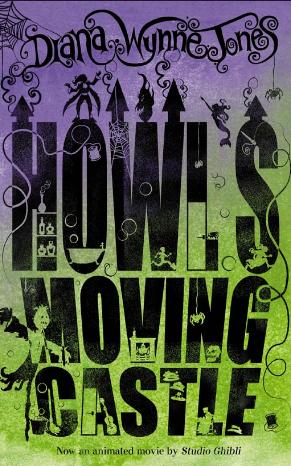


The Ladies of Grace Adieu, again from Amazon, the very soft tones of the book cover may be hard to see here. The flowers are picked out in flock, giving the book a luxurious feel even in paper back- and a welcome change from UV-Gloss.

The hardcover was similarly opulent (image from Borders.co.uk):
Sci-Fi is harder for me to come up with ready examples, but I have never escaped this 1978 version of '1984' (Image from NY Times bookblog via designkultur) -

Famous graffiti artist Shepherd Fairy recently did a redesign of the often-issued book:

In both cases the illustrative elements are subsumed by the graphic, becoming like texture. The leather of the man and the black background are less important than the red circle on the blue field. Fairey's eye is made up of newsprint and wallpaper (domestic propaganda). But layering artfully is a bit like throwing lots of good ingredients into a mixing bowl and then carefully arranging the outcome- it's almost like you can't go wrong. I want something more purposeful, therefore... minimal?
Dianna Wynn Jones' Howl books, images from Amazon and the excellent Nina Tara, who is responsible for these designs:



The Ladies of Grace Adieu, again from Amazon, the very soft tones of the book cover may be hard to see here. The flowers are picked out in flock, giving the book a luxurious feel even in paper back- and a welcome change from UV-Gloss.

The hardcover was similarly opulent (image from Borders.co.uk):

Sci-Fi is harder for me to come up with ready examples, but I have never escaped this 1978 version of '1984' (Image from NY Times bookblog via designkultur) -

Famous graffiti artist Shepherd Fairy recently did a redesign of the often-issued book:

In both cases the illustrative elements are subsumed by the graphic, becoming like texture. The leather of the man and the black background are less important than the red circle on the blue field. Fairey's eye is made up of newsprint and wallpaper (domestic propaganda). But layering artfully is a bit like throwing lots of good ingredients into a mixing bowl and then carefully arranging the outcome- it's almost like you can't go wrong. I want something more purposeful, therefore... minimal?
Friday, 16 April 2010
Research Photos From Yesterday (Image Heavy)
So yesterday we talked about how there were these trends in current fantasy book cover design.
Lets start with the one that seemed to begin with the 'His dark Materials' Trilogy. First image thanks to Wikimedia Commons.

So where did this lead to? Although the trend is a little expired now, we can still find plenty of examples of it (apologies that some of the images are a little dark, photographer-in-a-hurry-in-softly-lit-bookshops fail I'm afraid).
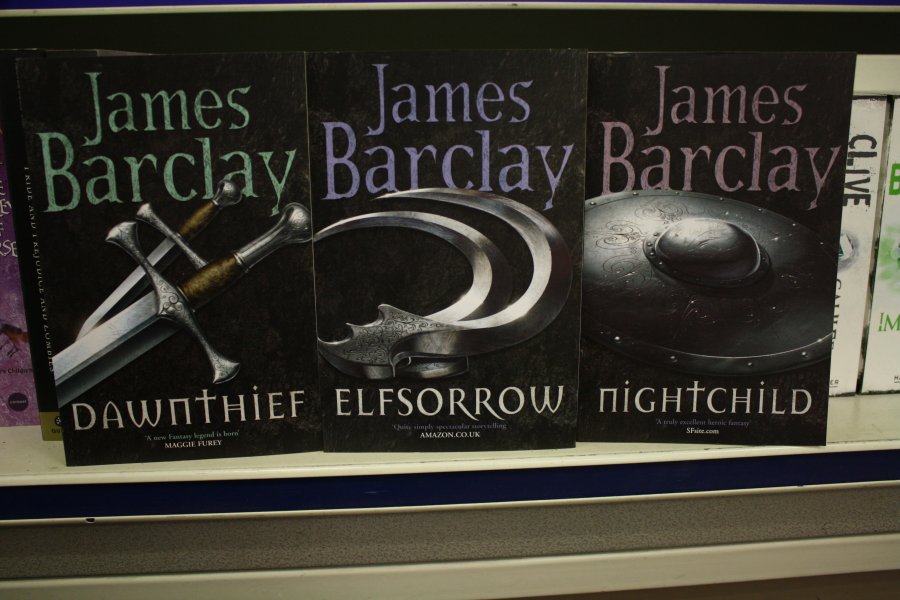


Now might be a good time to compare the Young vs Adult versions of the trilogy, and While we're at it the 'Harry Potter' series as well.
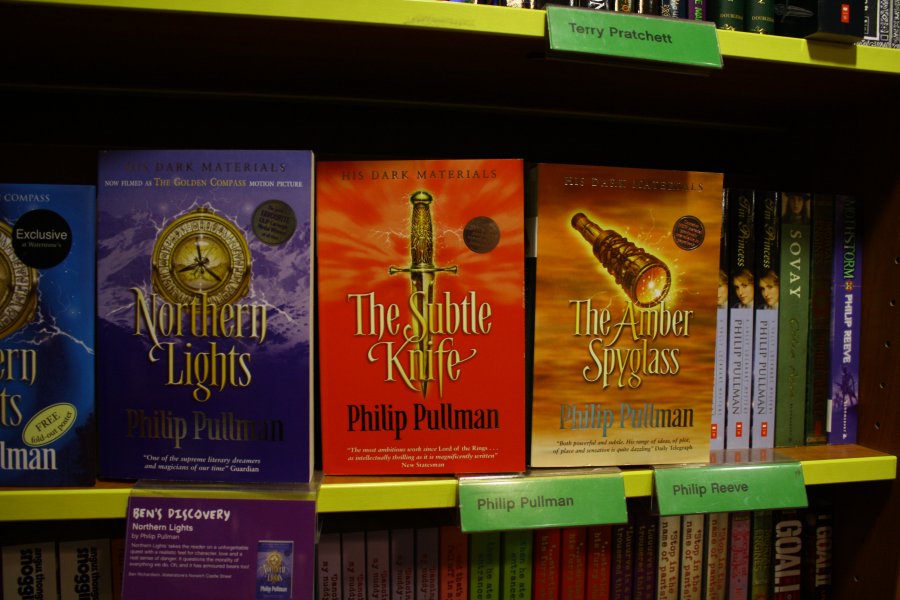
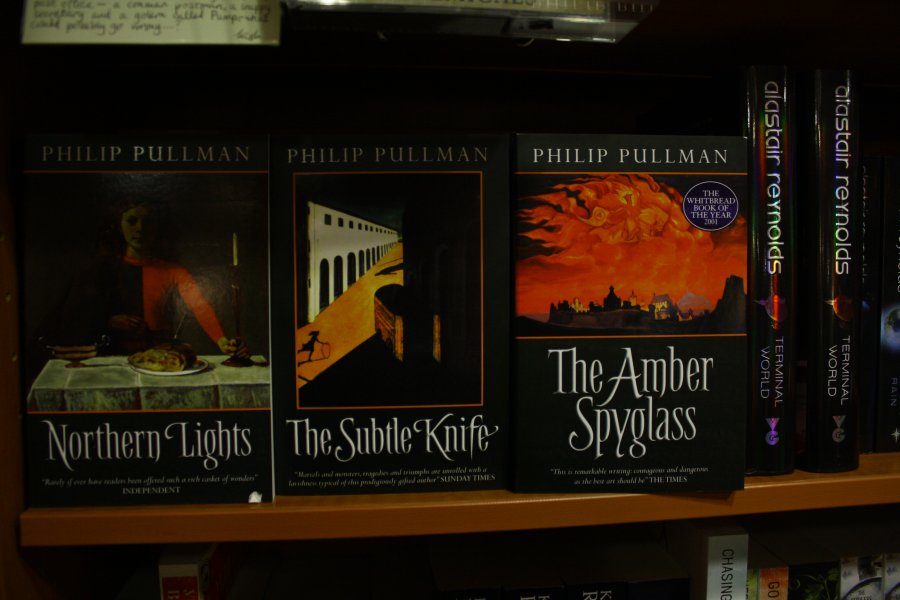
The type through consistent with both. They seem less ashamed to know each other than HP:

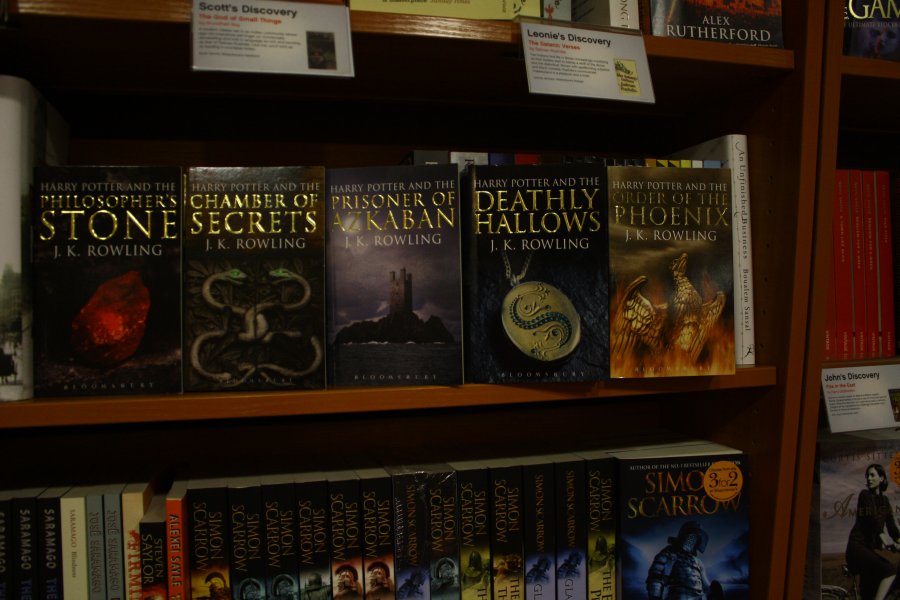
By now you should notice how these trends seem to be informing each other, it's a little more obvious in the later 'Discworld' editions:
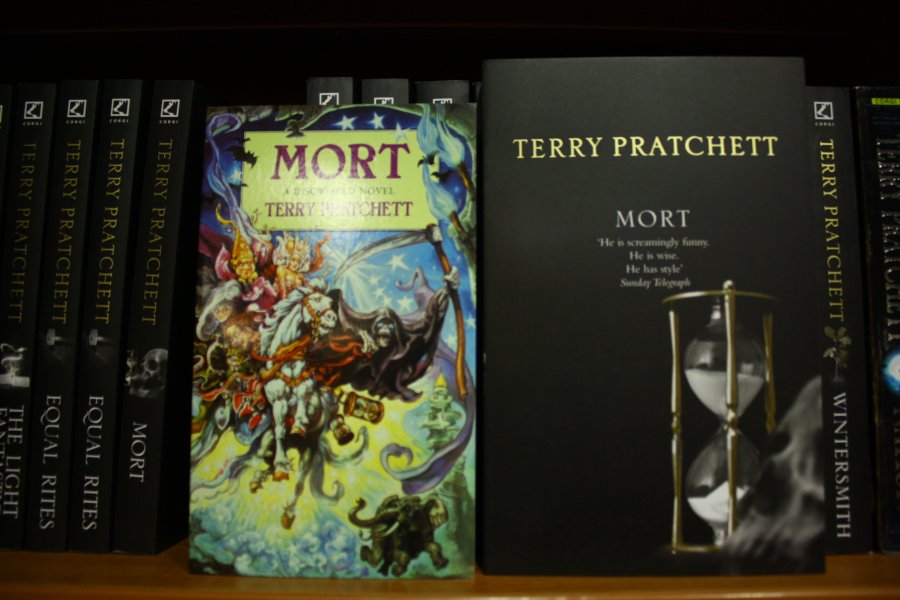
The black/object approaches seem to overlap or combine. Another key player seems to be the covers to the 'Abhorsen' Trilogy, which features a rare example of apt use of UV Gloss, where it creates an effect evoking the magical runes in the books, that can be seen by some and not others:

The books also use Kallos by Phil Grimshaw to great (and fairly) daring effect. I don't know if 'Lirael' was the starting point, but the monocromatic contre-jour landscape and figure are also popular:
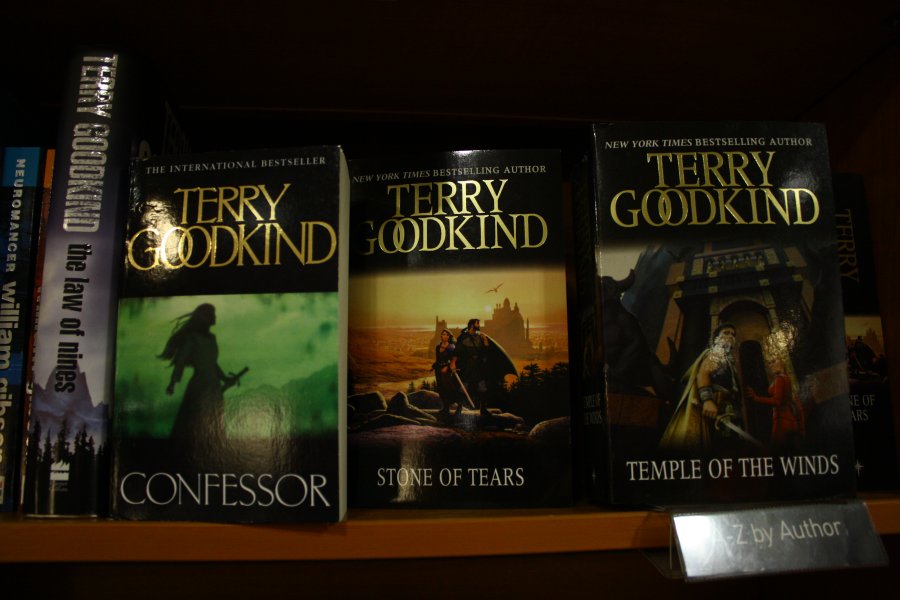
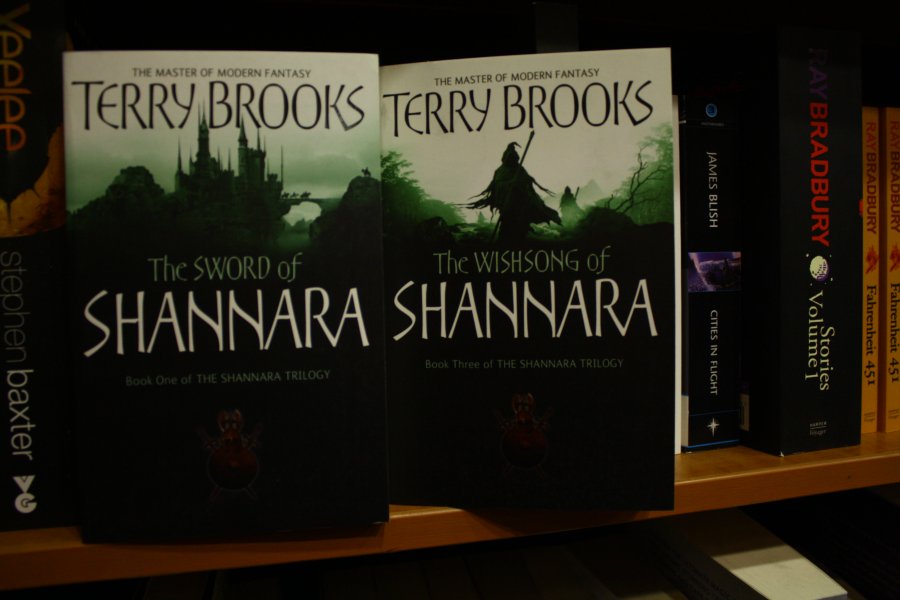
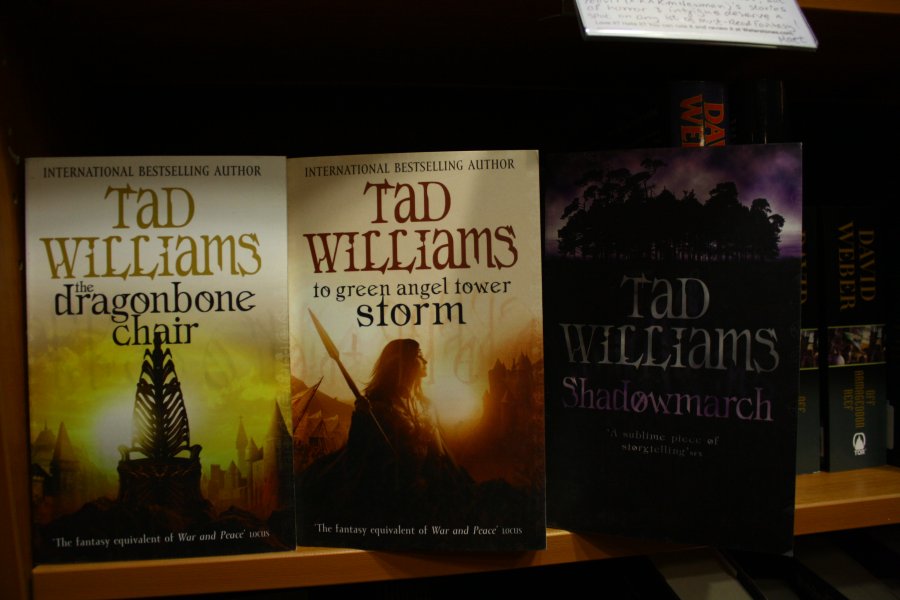
Figures alone- are preferred especially Hooded, armed and witha sweeping cloack. This one seems to be the type specimen:

Don't you hate iot when somebody turns up to the party in the same outfit as you?
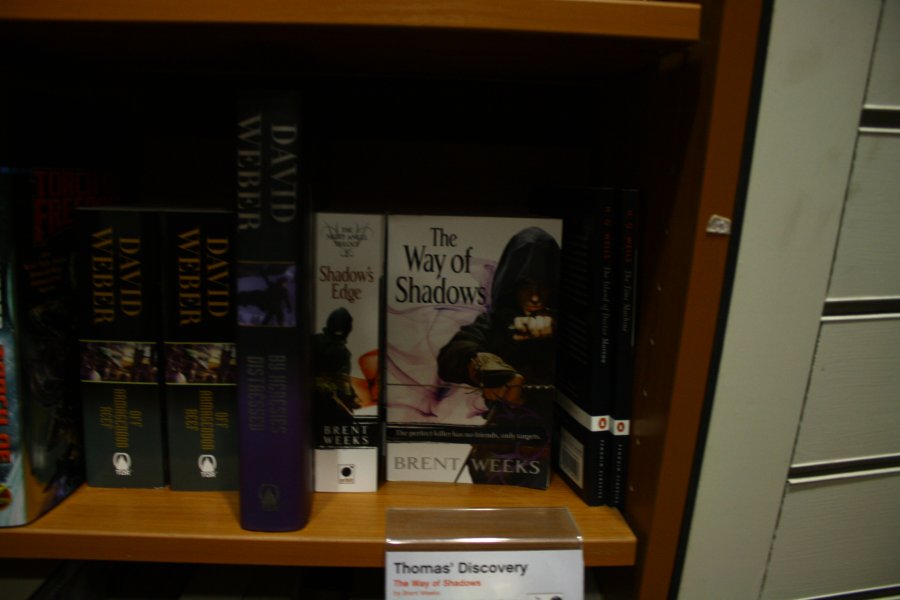
Although this one I quite like- it actually does something with the image and colour tints:

We should pause to consider that these books are part of their own series, which we might expect some internal consistency from. Readers buy one book after the other, expecting the next sequel to match the last on their shelves. Fantasy and SF fans also tend to collect by author (like the rest of us) so books by the same author will look as if they are part of a series, for the same reason. Here we see staple (but probably appropriate) fantasy images in a set layout for David Gemmel, who writes fairly definitive 'hack and slash' fantasy books:
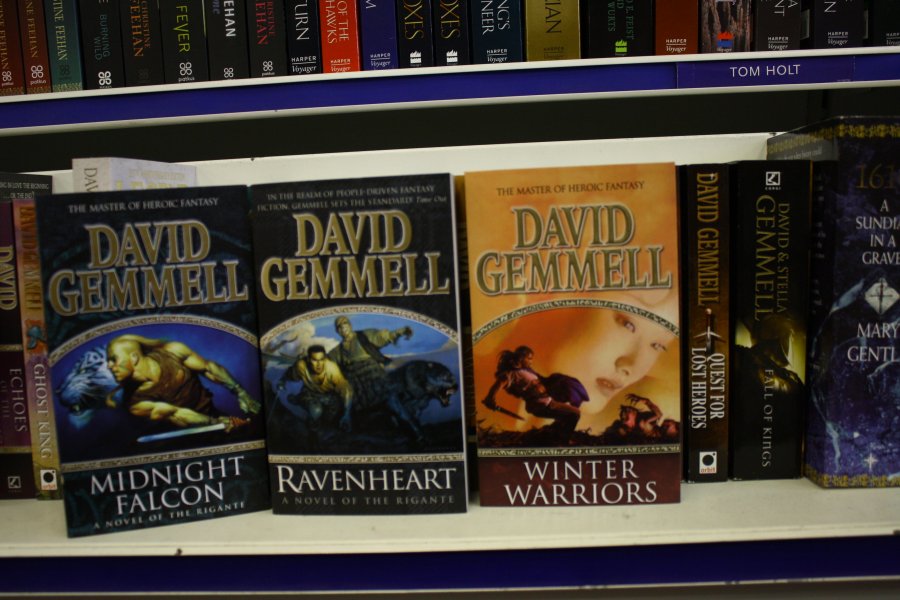
But what interests me is the overlap of these trends across series and author. The art isn't bad per se- but it is predictable and raises the question of originality in the art direction- perhaps that is a concern that is eschewed in favour of equally predictable sales? I also question the imagination of illustration as an approach. The artists can't be faulted for the imagination or skill, but if the question is "represent the book's content visually" is the most creative answer really "draw a picture of it?"
The pictures themselves are so relied upon that Gollancz feel confident to solarize and 'gradient-map' their covers in trying to achieve a similar goal to my brief:
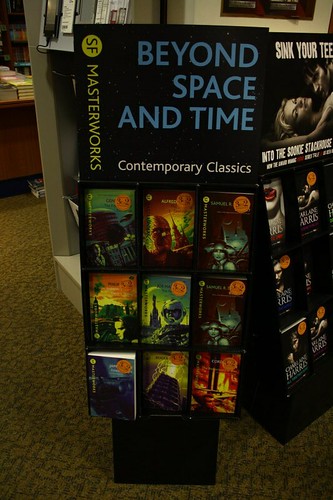
It's fairly striking, but not exactly revolutionary. Science fiction continues to rely on the classic imagery of spaceships and planets, although heightened by rigid and sharp typography and layout:
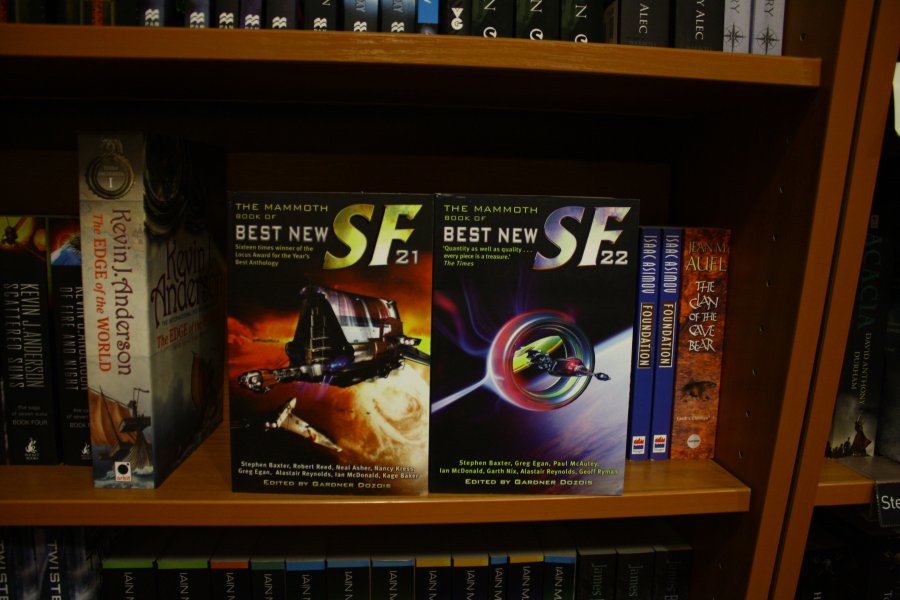

See also the 'The Culture' series, and Peter F Hamilton and Kevin J Anderson's books for really, more of the same- apt though. The Prismatic substrate here is a nice touch, but other than that, what really distinguishes it from the rest of the books in the section?
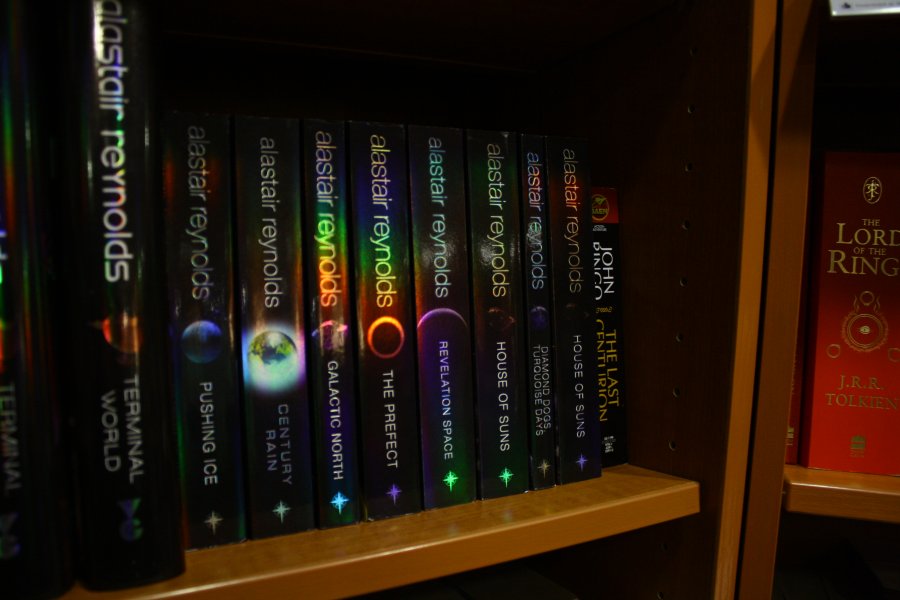
Perhaps more than fantasy the science fiction books seemed to be be different shade of the same colour, whereas I would like to see a Broader spectrum entirely. As I suspected, this only seems to occurs when a book is considered a classic or of some additional literary value, such as those by HG wells and JG Ballad:
Penguin's usual skill in art selection is evident:
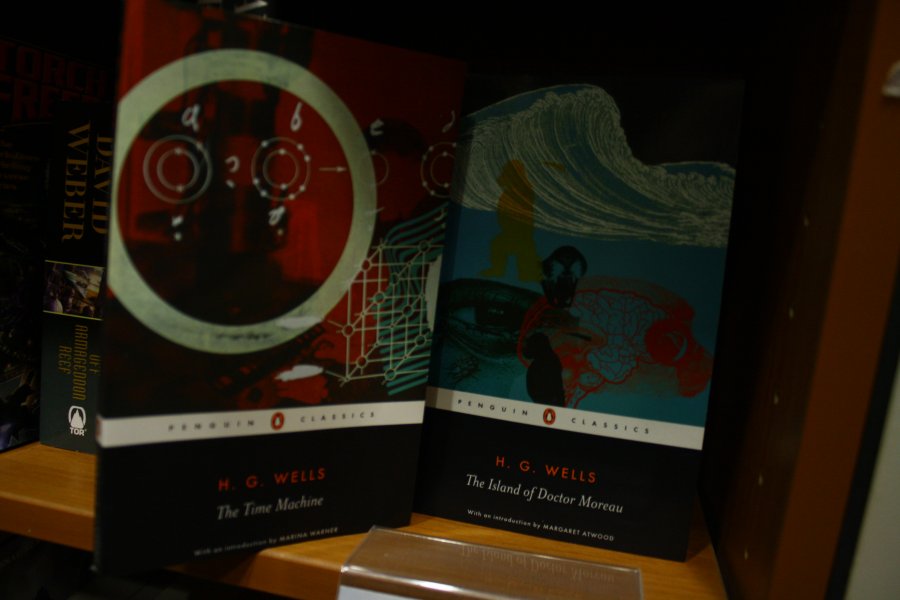
The Ballard books are much more interesting to me, an obvious effort to push the author:, stencil effects and dislocated squares of colour evoking the dystopic, alienated urban futures of his settings, bold and not directly illustrative, a step in the direction I want to go:
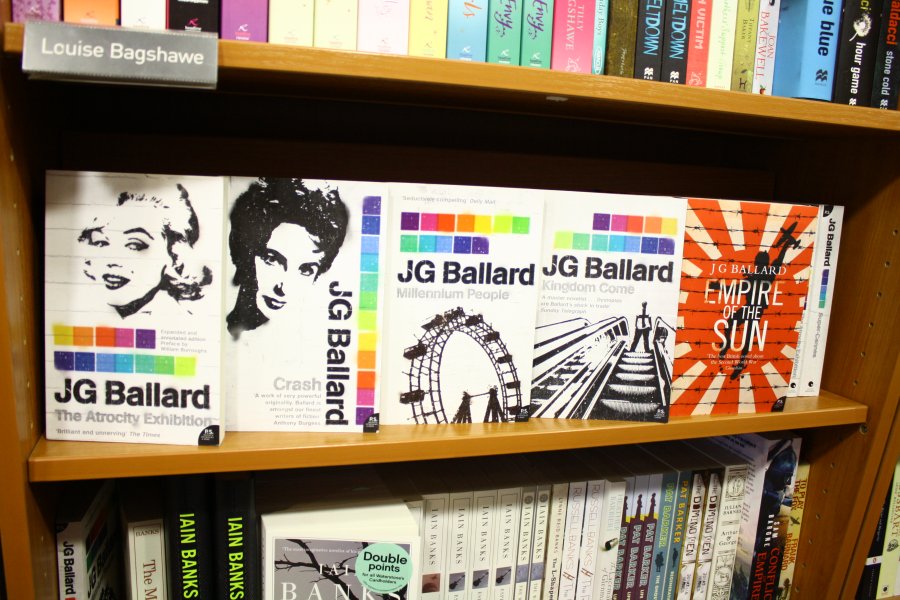
I was really quite impressed by the Ballard books, lets just look at how they stack as a set:
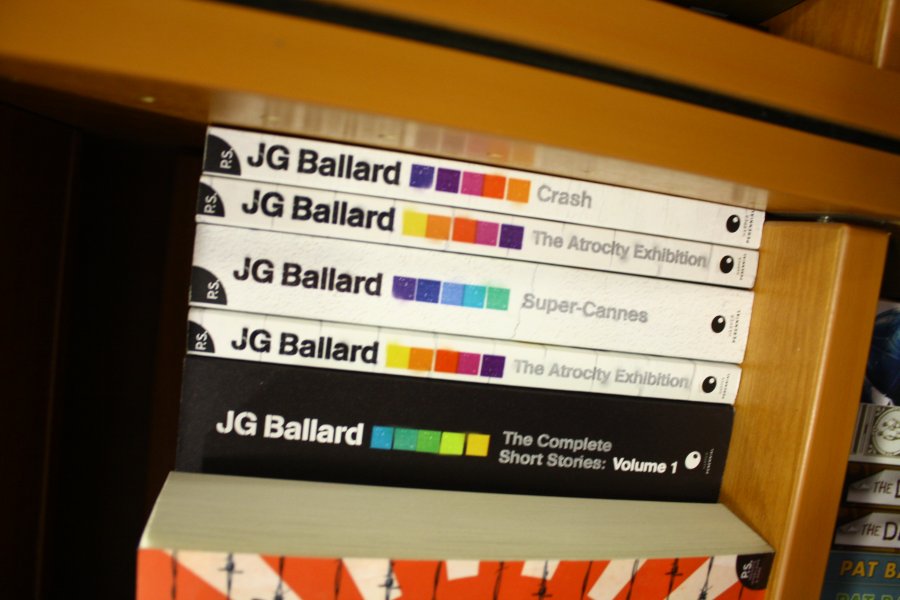
What else did I find?
All Vampire /Dark Fantasy (according to Waterstone's) look the same as well. Yawn. And over use UV gloss for apparently arbitrary gothic textures. Double yawn.
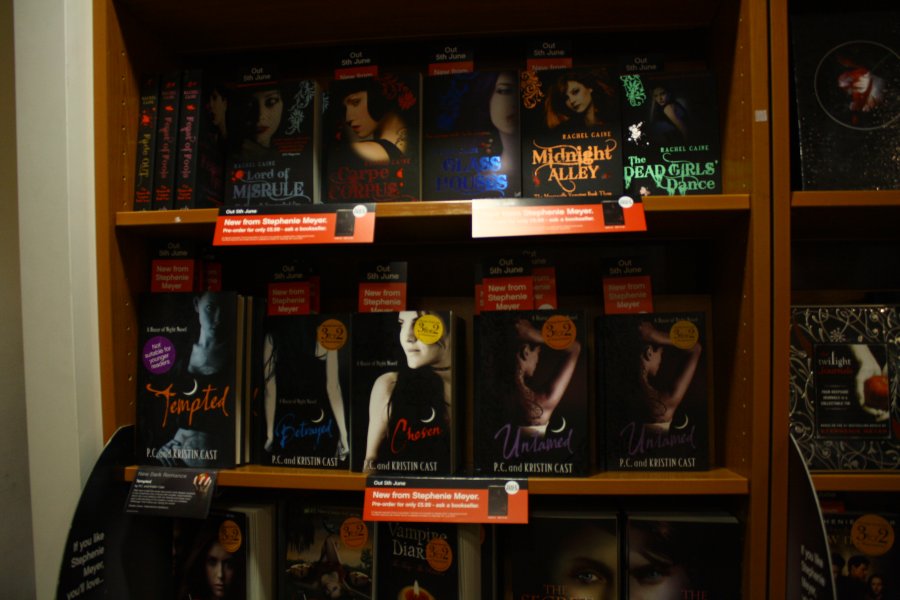
Except the Anne Rice ones, thanks to the gorgeous (hand?) lettering of Kate Forrester:
http://kateforrester1.blogspot.com/2008/12/anne-rice-novels-typography.html
So did I find anything that really surprised me? Well... no. I knew what the hell I was talking about when I wrote the brief. I was pleased by the quality of what was produced, even if I was unsurprised by it's sameyness. And it really isn't limited to fantasy. Similar problems with crime fiction- Sans Serif coloured type over an enigmatic face/picture of a female back pushing the author and title. Family drama with tragedy books of the like by Jodi Picault have the a same soft/out-of-focus scene of tenuous domesticity and sensible faces (white, for preference) for author and title. 'The Girl Who kicked the Hornets Nest' seems to exemplify the former trend. Like all design, there is a tendancy toward efficent following of forms and trends. And this has the desired effect- to make something recognizable and desirable by the target audience. And Hats off to book cover designers who do that work. They have a lot to do and tight deadline and many factors to balance- art directors, editors, authors and retailers all have to be considered at one stage or another. Compared to that pressure to be conservative, Kim Harrisons series actually get extra kudos, even though I'd prevously found their layout a little leaden:

And there were a couple of books that I like for various reasons. Mortlock inks the edged of the pages black, making it a striking artifact on the shelf. If I had £8.99 and a month off to read in, I probably would have got it:
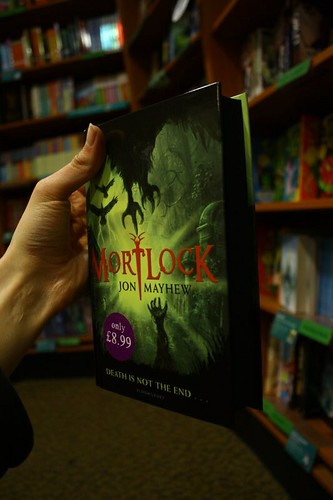
Most of the covers were uninspiring to me, only one or two exceptions:
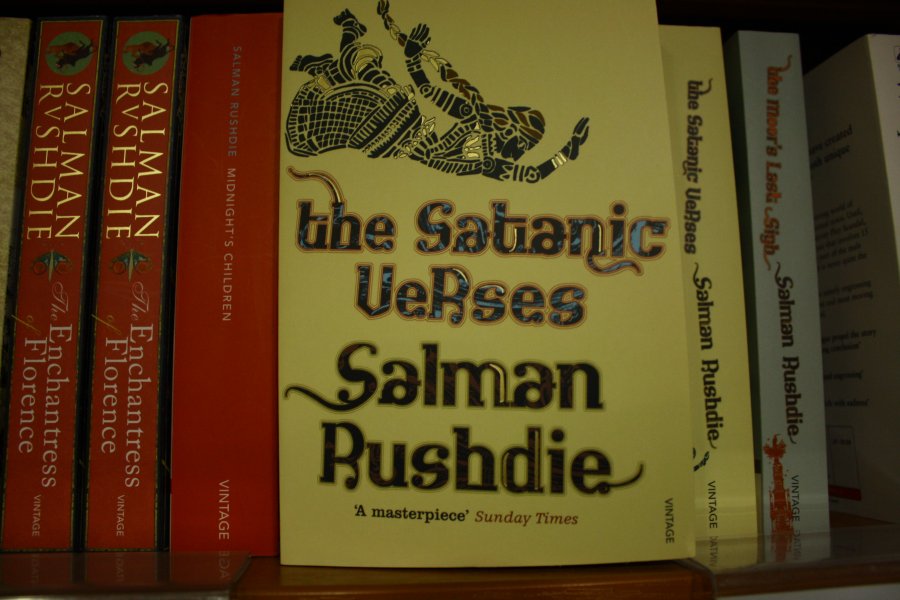
The paperback editions of Stephen Fry's books with the animals should also be mentioned. Anything to do with Stephen Fry should be mentioned, and often.
Tomorrow I will put up some images of book and DVD designs that I do like, and make some way to deciding what I want to do.
Stay lucky, everyone :)
ETA: More of The Harry Potter Books http://www.greghinzmann.com/?m=200707. Early 'adult edition' top right. It seems so '90s' compared to what we have now. The past is another country.
Lets start with the one that seemed to begin with the 'His dark Materials' Trilogy. First image thanks to Wikimedia Commons.

So where did this lead to? Although the trend is a little expired now, we can still find plenty of examples of it (apologies that some of the images are a little dark, photographer-in-a-hurry-in-softly-lit-bookshops fail I'm afraid).



Now might be a good time to compare the Young vs Adult versions of the trilogy, and While we're at it the 'Harry Potter' series as well.


The type through consistent with both. They seem less ashamed to know each other than HP:


By now you should notice how these trends seem to be informing each other, it's a little more obvious in the later 'Discworld' editions:

The black/object approaches seem to overlap or combine. Another key player seems to be the covers to the 'Abhorsen' Trilogy, which features a rare example of apt use of UV Gloss, where it creates an effect evoking the magical runes in the books, that can be seen by some and not others:

The books also use Kallos by Phil Grimshaw to great (and fairly) daring effect. I don't know if 'Lirael' was the starting point, but the monocromatic contre-jour landscape and figure are also popular:



Figures alone- are preferred especially Hooded, armed and witha sweeping cloack. This one seems to be the type specimen:

Don't you hate iot when somebody turns up to the party in the same outfit as you?

Although this one I quite like- it actually does something with the image and colour tints:

We should pause to consider that these books are part of their own series, which we might expect some internal consistency from. Readers buy one book after the other, expecting the next sequel to match the last on their shelves. Fantasy and SF fans also tend to collect by author (like the rest of us) so books by the same author will look as if they are part of a series, for the same reason. Here we see staple (but probably appropriate) fantasy images in a set layout for David Gemmel, who writes fairly definitive 'hack and slash' fantasy books:

But what interests me is the overlap of these trends across series and author. The art isn't bad per se- but it is predictable and raises the question of originality in the art direction- perhaps that is a concern that is eschewed in favour of equally predictable sales? I also question the imagination of illustration as an approach. The artists can't be faulted for the imagination or skill, but if the question is "represent the book's content visually" is the most creative answer really "draw a picture of it?"
The pictures themselves are so relied upon that Gollancz feel confident to solarize and 'gradient-map' their covers in trying to achieve a similar goal to my brief:

It's fairly striking, but not exactly revolutionary. Science fiction continues to rely on the classic imagery of spaceships and planets, although heightened by rigid and sharp typography and layout:


See also the 'The Culture' series, and Peter F Hamilton and Kevin J Anderson's books for really, more of the same- apt though. The Prismatic substrate here is a nice touch, but other than that, what really distinguishes it from the rest of the books in the section?

Perhaps more than fantasy the science fiction books seemed to be be different shade of the same colour, whereas I would like to see a Broader spectrum entirely. As I suspected, this only seems to occurs when a book is considered a classic or of some additional literary value, such as those by HG wells and JG Ballad:
Penguin's usual skill in art selection is evident:

The Ballard books are much more interesting to me, an obvious effort to push the author:, stencil effects and dislocated squares of colour evoking the dystopic, alienated urban futures of his settings, bold and not directly illustrative, a step in the direction I want to go:

I was really quite impressed by the Ballard books, lets just look at how they stack as a set:

What else did I find?
All Vampire /Dark Fantasy (according to Waterstone's) look the same as well. Yawn. And over use UV gloss for apparently arbitrary gothic textures. Double yawn.

Except the Anne Rice ones, thanks to the gorgeous (hand?) lettering of Kate Forrester:
http://kateforrester1.blogspot.com/2008/12/anne-rice-novels-typography.html
So did I find anything that really surprised me? Well... no. I knew what the hell I was talking about when I wrote the brief. I was pleased by the quality of what was produced, even if I was unsurprised by it's sameyness. And it really isn't limited to fantasy. Similar problems with crime fiction- Sans Serif coloured type over an enigmatic face/picture of a female back pushing the author and title. Family drama with tragedy books of the like by Jodi Picault have the a same soft/out-of-focus scene of tenuous domesticity and sensible faces (white, for preference) for author and title. 'The Girl Who kicked the Hornets Nest' seems to exemplify the former trend. Like all design, there is a tendancy toward efficent following of forms and trends. And this has the desired effect- to make something recognizable and desirable by the target audience. And Hats off to book cover designers who do that work. They have a lot to do and tight deadline and many factors to balance- art directors, editors, authors and retailers all have to be considered at one stage or another. Compared to that pressure to be conservative, Kim Harrisons series actually get extra kudos, even though I'd prevously found their layout a little leaden:

And there were a couple of books that I like for various reasons. Mortlock inks the edged of the pages black, making it a striking artifact on the shelf. If I had £8.99 and a month off to read in, I probably would have got it:

Most of the covers were uninspiring to me, only one or two exceptions:

The paperback editions of Stephen Fry's books with the animals should also be mentioned. Anything to do with Stephen Fry should be mentioned, and often.
Tomorrow I will put up some images of book and DVD designs that I do like, and make some way to deciding what I want to do.
Stay lucky, everyone :)
ETA: More of The Harry Potter Books http://www.greghinzmann.com/?m=200707. Early 'adult edition' top right. It seems so '90s' compared to what we have now. The past is another country.
Subscribe to:
Posts (Atom)
